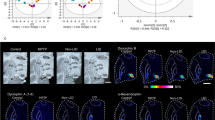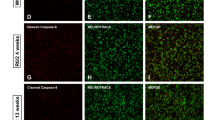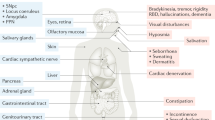Abstract
Intrastriatal injections of excitotoxic amino acids and their analogues (for example kainate and ibotenate) elicit a pattern of neuronal degeneration that is similar in many respects to that observed in Huntington's disease1,7. In this disease there is a progressive degeneration of most types of intrinsic neuron but somatostatin and neuropeptide Y levels are increased 3–5-fold8–11. This may be attributed to the selective preservation of a sub-class of striatal aspiny neurons, in which these two peptides are co-localized together with the enzyme NADPH-diaphorase (refs 11–15). Beal et al. reported recently that following intrastriatal injections of quinolinic acid in rats, medium-sized aspiny neurons were selectively preserved and they suggested that quinolinic acid which is found in human brain might cause the neuronal degeneration seen in Huntington's disease4. We have used immunocytochemical and enzyme histochemical techniques to examine this selective toxicity but find no evidence to support this finding. We conclude that there are substantial differences between the immuno-cytochemical changes detected in postmortem Huntington's disease brain and those following quinolinic-acid-induced degeneration.
This is a preview of subscription content, access via your institution
Access options
Subscribe to this journal
Receive 51 print issues and online access
$199.00 per year
only $3.90 per issue
Buy this article
- Purchase on Springer Link
- Instant access to full article PDF
Prices may be subject to local taxes which are calculated during checkout
Similar content being viewed by others
References
1. Coyle, J. T. & Schwarcz, R. Nature 263, 244–246 (1976). 2. McGeer, E. G. & McGeer, P. L. Nature 263, 517–519 (1976). 3. Schwarcz, R. et al. Expl Brain Res. 37, 199–216 (1979). 4. Beal, M. F. et al Nature 321, 168–171 (1986). 5. Kohler, C. & Schwarcz, R. Neuroscience 8, 819–835 (1983). 6. McBean, G. J. & Roberts, P. J. /. Neurochem. 44, 247–254 (1985). 7. Schwarcz, R., Whetsell, W. O. & Mangano, R. M. Science 219, 316–319 (1983). 8. Spokes, E. G. S. Trends Neurosci. 4, 115–118 (1981). 9. Aronin, N. et al. Ann. Neurol. 13, 519–526 (1983). 10. Beal, M. R, Bird, E. D., Langlais, P. J. & Martin, J. B. Neurology 34, 663–666 (1984). 11. Dawbarn, D., De Quidt, M. E. & Emson, P. C. Brain Res. 340, 251–260 (1985). 12. Ferrante, R. J., Kowall, N. W., Martin, J. B. & Richardson, E. P. Jr /. Neuropath, exp. Neurol. 4, 325 (1985). 13. Chesselet, M. F. & Graybiel, A. M. Neuroscience 17, 547–573 (1986). 14. Sandell, J. H., Graybiel, A. M. & Chesselet, M.–F. J. comp. Neurol. 243, 326–334 (1986). 15. Vincent, S. R. et al J. comp. NeuroL 217, 252–263 (1983). 16. McLean, I. W. & Nakane, P. K. /. Histochem. Cytochem. 22, 1077–1083 (1974). 17. Mazzari, S., Aldinio, C, Beccaro, M., Toffano, G. & Schwarcz, R. Brain Res. 380, 309–317 (1986). 18. Beal, M. F. & Martin, J. B. Brain Res. 266, 67–73 (1983). 19. Karnovsky, M. J. & Roots, L. /. Histochem. Cytochem. 12, 219–221 (1964). 20. Vincent, S. R., Staines, W. A. & Fibiger, H. C. Neurosci. Lett. 35, 111–114 (1983). 21. Hsu, S. M., Raine, L. & Fange, R. H. / Histochem. Cytochem. 29, 577–580 (1981). 22. Davies, S. W. & Kohler, C. Anat. Embryol. 173, 45–52 (1985).
Author information
Authors and Affiliations
Rights and permissions
About this article
Cite this article
Davies, S., Roberts, P. No evidence for preservation of somatostatin-containing neurons after intrastriatal injections of quinolinic acid. Nature 327, 326–329 (1987). https://doi.org/10.1038/327326a0
Received:
Accepted:
Issue Date:
DOI: https://doi.org/10.1038/327326a0
This article is cited by
-
Somatostatin in Medium-Sized Aspiny Interneurons of Striatum is Responsible for Their Preservation in Quinolinic Acid and N-Methyl-d-Asparate-Induced Neurotoxicity
Journal of Molecular Neuroscience (2008)
-
Short-term lithium treatment promotes neuronal survival and proliferation in rat striatum infused with quinolinic acid, an excitotoxic model of Huntington's disease
Molecular Psychiatry (2004)
-
Excitotoxicity of quinolinic acid: Modulation by endogenous antagonists
Neurotoxicity Research (2000)
-
Modulation of striatal quinolinate neurotoxicity by elevation of endogenous brain kynurenic acid
British Journal of Pharmacology (1998)
Comments
By submitting a comment you agree to abide by our Terms and Community Guidelines. If you find something abusive or that does not comply with our terms or guidelines please flag it as inappropriate.



